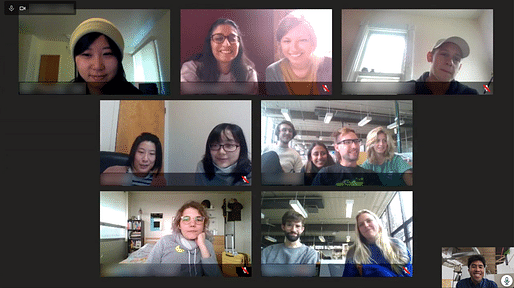

As the spread of the novel coronavirus prompts a cascade of event cancellations and school closures, the rest of the Spring 2020 semester hangs in the balance for many design students and educators.
Just this week, Columbia University, Princeton University, Harvard University, The Ohio State University, the University of Pennsylvania, and University of California, Berkeley and others have announced school closures to varying degrees as these institutions formulate plans for moving instruction out of the classroom and onto the internet for (at least) the remainder of the semester. At many universities, mid-reviews are just around the corner or have just taken place, leaving the remaining half-semester in limbo for students and professors, alike.
As educational institutions transition toward a yet-to-be-determined period of all-remote coursework, the deeply social culture of design studio is being challenged from multiple angles, as well.
Anyone who has been through architecture school will tell you that studio can be a formative shared (and often grueling) experience that is synonymous with both the space it takes place in (the physical studio) but also, with the cohort of students, instructors, and aids who help bring design work to life (the studio). And while most of the universities mentioned above have yet to work out a system for transitioning desk crits and design reviews online, there are examples of online studio culture taking root around the country.
One example comes from the University of Michigan, where the Center for Academic Innovation has been working to develop and institute new approaches for learning that are finding unexpected applications during the coronavirus scare. The effort has translated to some of the activities taking place at the design studio level within U of M's Taubman College of Architecture and Urban Planning, where design instructors have worked to bring in design critics remotely in an effort to cut down on unnecessary travel and to help reduce carbon emissions.
In recent weeks, however, these experiments have taken on a greater degree of urgency as the coronavirus has spread.
Remote and alternative design studio setups have been an ongoing interest for Taubman Assistant Professor of Architecture Cyrus Peñarroyo, who is teaching a thesis section this semester that falls at the intersection of architecture and media culture. In the studio, Peñarroyo and his students are exploring a variety of approaches for handling design critiques and reviews remotely, including distance learning and shared work sessions.
Utilizing the power of conferencing platforms like BlueJeans and Google Drive, Peñarroyo and his students are exploring ways of decoupling design feedback from the physical confines of the studio space. During a recent desk crit session, for example, Peñarroyo met remotely with his students to provide feedback on ongoing design work. Peñarroyo, conferencing in from his personal work space, met digitally with students, half of whom were working in studio (in-person courses are still taking place at U of M, but students are being offered remote options), while the others were working from home or other locations. Working with two students at time, Peñarroyo was able to offer feedback on design work through a mix of digital platforms. Peñarroyo explains, “I can see their faces on BlueJeans, and they can share their screens with me via their computers. So the person presenting shares an in-process Rhino model, for example, or they share PDFs or slideshows they have produced.”
“It's all up in the air right now,” Peñarroyo explains, referring to whether the approach will be more widely implemented, "If anything, this situation reveals the challenges posed by internet inequality in this country." Peñarroyo adds, “I think it is possible, given the desk crits that I had yesterday, when I met with all of my students. It seems like it is possible to do this with external critics in different time zones Skyping at the same time, too. As long as the infrastructure is in place and there's enough data and bandwidth, I think it could work.”
For the course, students are leaving comments on one another's work via a shared Google Drive, while plans for conferencing in outside critics for the final reviews are in the works. The approach is actually preferable for some students, Peñarroyo explains, as it can take some of the stress of the review performance itself off of these budding designers.
Alternative critique and review approaches create “multiple spaces for interaction” Peñarroyo adds, “It provides a different level of engagement and can feel more direct and less performative. It also means that students have flexibility and more than one space to engage in design with.”
1 Comment
Love this post and great example by Cyrus! I would love to see this discussion continue and how others are implementing virtual classes, discussions, reviews, etc.
Block this user
Are you sure you want to block this user and hide all related comments throughout the site?
Archinect
This is your first comment on Archinect. Your comment will be visible once approved.